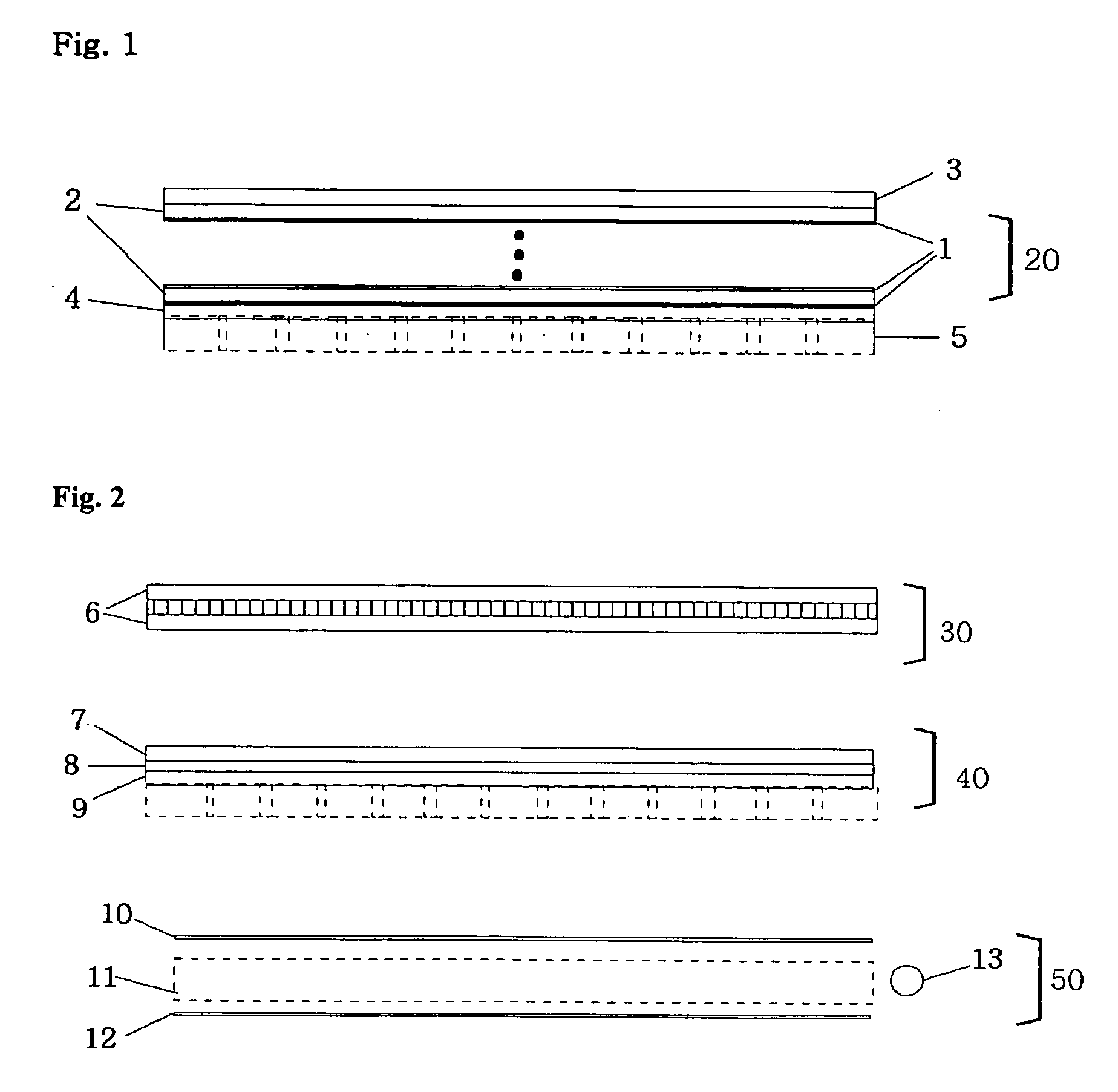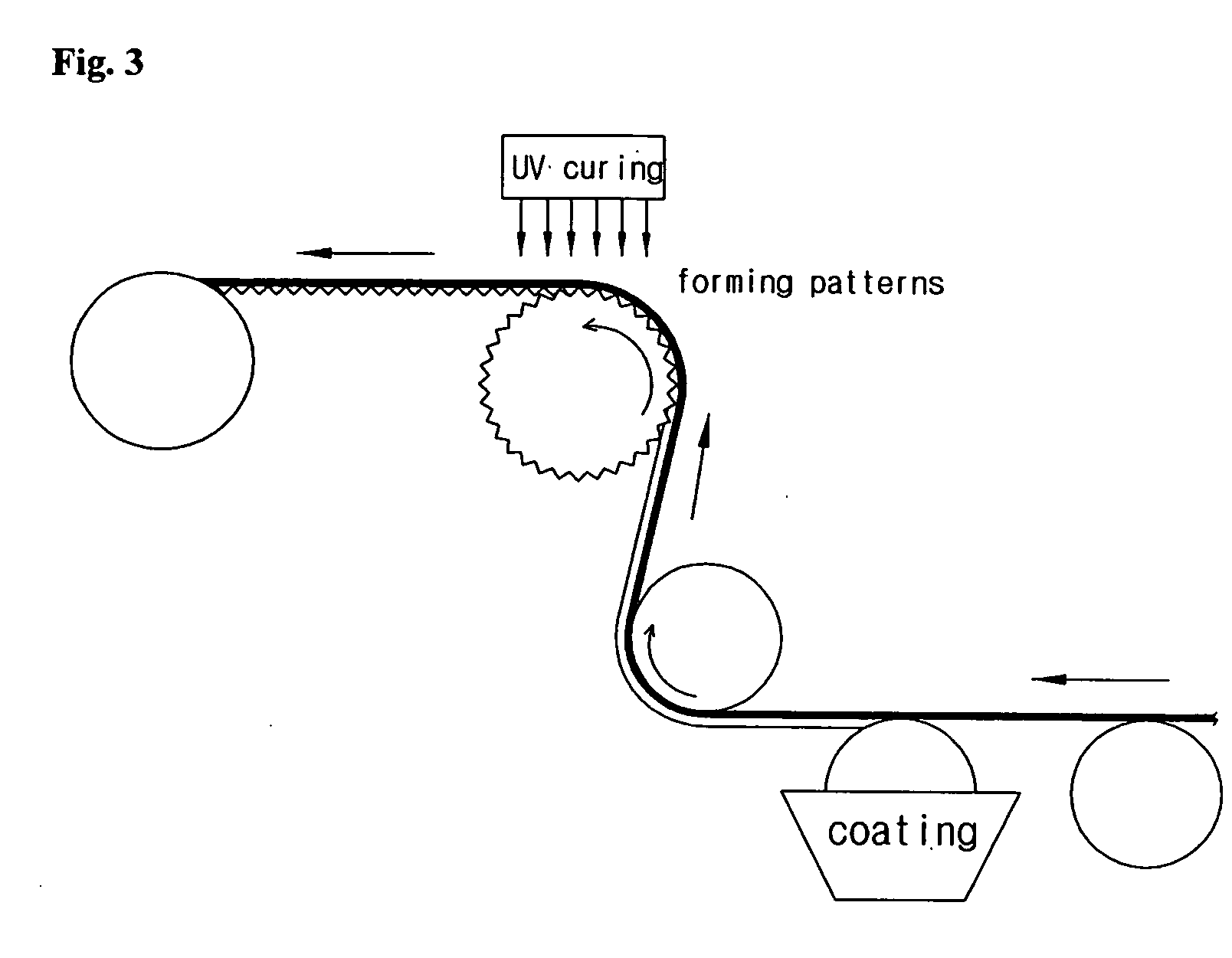Prism-patterned broadband reflective polarizer for liquid crystal display
a technology of reflective polarizer and liquid crystal display, which is applied in the direction of optics, instruments, optical elements, etc., can solve the problems of reducing the picture quality of the lcd, reducing the function of polarization, and not being practicable in manufacturing the above-mentioned polarizing film, so as to prevent light scattering phenomena and improve brightness to the maximum
- Summary
- Abstract
- Description
- Claims
- Application Information
AI Technical Summary
Benefits of technology
Problems solved by technology
Method used
Image
Examples
embodiment 1
Preferred Embodiment 1
[0032] Firstly, a cholesteric liquid crystal film is manufactured. A solution of 50-weight % thermosetting cholesteric liquid crystal material (of BASF Company, LC242 and LC756) dissolved in a mixed solvent of methylethylketone (MEK) and toluene at a ratio of 6:4 is manufactured. Each solution is prepared for to have a selective reflection central wavelength of 430, 480, 520, 580, 650, or 720 nm by adjusting the ratio of mixing of the nematic material (LC242) and the chiral material (LC756), and a 5-weight % photoinitiator (IG184 of Ciba-Geigy Corporation) and a 0.2-weight % leveling additive (BYK361 of BYK Corporation) are added to each solution. Among the solutions manufactured in the above, firstly, the 430-nm solution is coated thinly onto a polyethylene terephthalate (PET) film in the roll coating method. After coating, the liquid crystal of the solution is oriented while drying the solvent in a dryer, after which a film is made through the irradiation wit...
embodiment 2
Preferred Embodiment 2
[0036] Firstly, a cholesteric liquid crystal film is manufactured. A solution of 50-weight % thermosetting cholesteric liquid crystal material (of BASF Company, LC242 and LC756) dissolved in a mixed solvent of methylethylketone (MEK) and toluene at a ratio of 6:4 is manufactured. Each solution is prepared for to have a selective reflection central wavelength of 435, 485, 520, 570, 620, 670, or 730 nm by adjusting the ratio of mixing of the nematic material (LC242) and the chiral material (LC756), and a 5-weight % photoinitiator (IG184 of Ciba-Geigy Corporation) and a 0.2-weight % leveling additive (BYK361 of BYK Corporation) are added to each solution. Among the solutions manufactured in the above, firstly, the 435-nm solution is coated thinly onto a polyethylene terephthalate (PET) film in the roll coating method. After coating, the solvent is dried in a dryer, after which a film is made through the irradiation with UV light. The drying condition is at a tempe...
PUM
| Property | Measurement | Unit |
|---|---|---|
| thickness | aaaaa | aaaaa |
| angle | aaaaa | aaaaa |
| thickness | aaaaa | aaaaa |
Abstract
Description
Claims
Application Information
 Login to View More
Login to View More - R&D
- Intellectual Property
- Life Sciences
- Materials
- Tech Scout
- Unparalleled Data Quality
- Higher Quality Content
- 60% Fewer Hallucinations
Browse by: Latest US Patents, China's latest patents, Technical Efficacy Thesaurus, Application Domain, Technology Topic, Popular Technical Reports.
© 2025 PatSnap. All rights reserved.Legal|Privacy policy|Modern Slavery Act Transparency Statement|Sitemap|About US| Contact US: help@patsnap.com



